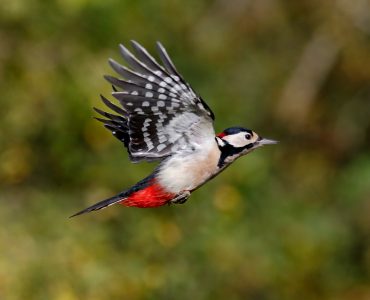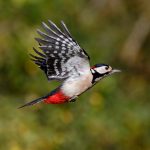The bird, Green woodpecker belongs to the family of picidae and has four subspecies in the set. The bird is quite common in the region across western Asia to Europe. Scientifically, it is known as Picus Viridis. The body tends to have a green coloured top and a pale yellow bottom.
The bird would normally have a 45-51 cm of wingspan and can be up to 30-36 cm in length. The top portion in both, male and female bird is greenish in colour, with a pale yellowish tune towards it’s below. The bird has a crown type of formation on its head, which is red in colour and a yellow rump and nape. The moustachial stripe would have a reddish centre for a male, which is absolutely black in case of a female bird. The eyes would have black lores both for male and female birds. The young ones of this bird would have reddish feathers which change their colour as they grow up. Those can also have a spotted or a streaked body in their initial days. The bird has quite a shy nature and can be tough to spot in very open areas. The calling is quite loud which is enough to draw attention. The noise of the bird’s call is very much in sync with its flying routine and increases while flying. The call gets a little sharper and louder towards the end of the flight and just before landing. It can have 3-4 beating of wings and then an undulating flight which would have a short glide with help of wings.
The bird has also been reportedly found quite similar to that of grey headed woodpecker but some basic characteristics should be help you differentiate between them. The yellowish under parts are the first point of difference, since the other has grey under parts. The lores are also black for a green woodpecker which is not the case of grey woodpecker.
The bird has a huge distribution across Europe, where it is present in more than 75% of its total count. There are few areas like Greenland, Ireland and macaronesian islands where it is completely absent but otherwise distributed throughout Europe. On the contrary, major numbers of this bird are recorded around Spain, Germany and France.
The bird makes large nesting holes in trees, which is quite same in the woodpecker family. Those nests could be a few feet above the ground on the tree. The normal choice of trees would range form the fruit trees to beeches, willows and oaks. The tree of choice is Aspen across Northern Europe. The eggs tend to incubate in around 15-20 days time and the parents take time in incubating those eggs.
The birds eat Ants as their primary food and take lot of time finding those ants across branches and ground. The adult ants and larvae is what come up, when they dig into an ant’s colony. They pick as many as ten varieties of ants and feed their young ones. Their beak interestingly is quite soft in nature and can dig into softer wood trees only.









